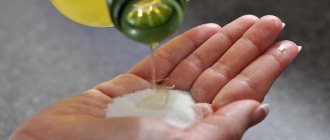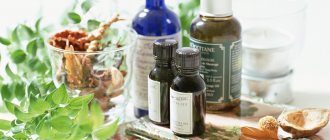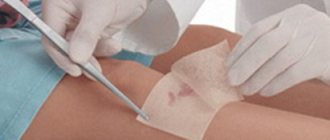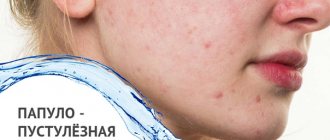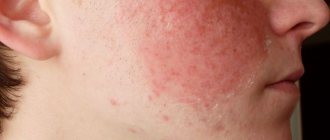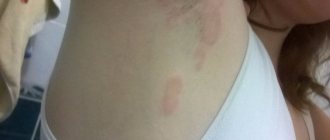Hello dear readers. Today I will share proven remedies that help treat a sore in the nose. Each of us has had a sore in the nose at least once. Agree, many have encountered painful formations in the nasal cavity. For some, they go away quickly, while others suffer from such sores for a long time. If mucus sores do not go away after a course of treatment with medications or the use of herbal remedies, you will need to consult an ENT doctor. There are many effective remedies; they actively act on the root cause that caused them.
Causes of a weeping wound
The main reason for the release of plasma through the wound surface is increased vascular permeability. Their walls become so thin that they are unable to retain water and other solutions. As a result, fluid appears on the surface of the wound, the release of which increases with movement.
The following factors trigger the mechanism of wound weeping:
- The addition of a bacterial, fungal or viral infection, which reduces local immunity and delays the first stage of regeneration (inflammatory process).
- The presence of chronic skin diseases.
- Lack of nutrients in the body necessary to maintain metabolic processes in the skin, resulting in increased dryness, cracks and micro-wounds.
- Allergic reactions, manifested in the form of skin irritation and itching.
- Presence of bedsores and other skin lesions.
It is important to understand that wound wetting is a natural process of the body that occurs as a defense against pathogenic microorganisms and other irritants affecting the wound. If fluid is released in large quantities, it means that there is additional damage to the wound that must be repaired to further the healing process. This important symptom helps to determine and evaluate how the regeneration process is proceeding.
What does a weeping wound look like?
But a weeping wound cannot be ignored. Constant hydration is an excellent breeding ground for the proliferation of pathogenic microorganisms, which can trigger an infectious-inflammatory process that will aggravate the wound healing process.
The following categories of patients are at risk:
- in the presence of diabetes mellitus;
- with the progression of thrombophlebitis and other vascular diseases;
- people with severe vitamin deficiency;
- patients who are constantly in a supine position.
If a weeping wound is left untreated for a long time, there is a risk of complications.
Reasons why a sore nose occurs
Such painful crusts can occur due to a number of completely different factors.
But the feeling that appears in the sinuses cannot be confused with anything.
Doctors have identified the most common factors that influence the presence of sores.
Viral infections (respiratory)
The disease itself does not cause sores or crusts to appear on the mucous surface of the nose.
They are formed as a result of ignoring the instructions for vasoconstrictor sprays or drops that improve breathing.
Their action, at high concentrations, provokes a strong narrowing of the capillaries, resulting in dryness in the nose.
Dry indoor air
When breathing exclusively dry air containing a lot of household dust, the mucous membrane dries out. This environment is ideal for the formation of sores on its surface.
Unfavorable environment
Air pollution, especially in megacities, has a negative effect on the mucous membrane in the nasal cavity.
Herpes
Infection with the herpes virus can also affect the inside of the nose, where blisters form. They can form a very painful crust.
Nasal sores can occur in both adults and children. Herpes on the inside of the nose can occur in children of all ages.
Imbalance in the functioning of internal organs
Relatively rarely, improper liver function manifests itself in the form of sores in the nose.
Dysfunction of the pancreas or thyroid gland affects the body's resistance to viruses.
At the same time, the barrier that protects the body from pathogenic flora becomes thinner.
With the naked eye you can see sores in the nose; they are a kind of crust.
Attention! Removal by mechanical means causes pain, leaving an inflamed area on the mucous membrane, and bleeding is also possible.
Photo of a sore in the nose
When a sore occurs in the nose, there is no need to worry, the most important thing is to take action.
All this can be successfully treated. This is what “sores in the nose” look like.
Clinical manifestations
It is not difficult to determine the presence of weeping. To do this, it is worth examining the surface of the wound, from which a clear liquid with a pinkish tint is slowly oozing. When it accumulates on the wound surface, plasma begins to flow down the body, drying to the skin and forming bruises.
The surface of the wound itself has a glossy, deep pink color. A small crust forms along the edges, rising slightly above the surface of the wound itself. When the plasma is removed, dryness and tightness of the wound immediately develops, which provokes pain, which intensifies with movement.
Why does the wound get wet?
The separation of fluid from the wound is accompanied by inflammation, the tissue around the wound turns red, and infection occurs in the affected area and under the skin around it. All the features of weeping wounds can be seen in the photo.
The wound does not dry out due to stretching of the edges
The wound heals on the finger for a long time due to its constant movement
The wound may not heal for a long time due to poor immunity
An ulcer on the leg takes a long time to heal; there will be discharge from the wound for almost the entire healing period
Blisters from burns are accompanied by lymph secretion
The clear liquid with a yellowish tint that oozes from the wound is called ichor or lymph.
There are a number of reasons why even the most minor damage to the skin becomes wet and does not heal for a long time:
- poor care of the affected area;
- elderly age;
- exhaustion, weak immunity;
- presence of diseases: diabetes, oncology, vascular diseases;
- violation of venous and lymphatic outflow;
- the presence of foreign objects in the wound;
- repeated injury to the same area;
- stretching the edges of the wound.
There are also skin lesions, the healing of which is always accompanied by the flow of lymph, these include:
- blisters from burns (laser, thermal, chemical);
- stitches after surgery;
- calluses on hands;
- trophic ulcers on the legs;
- bedsores on the back, back of the head, buttocks;
- navel of a newborn baby;
- wounds on the surface of which the skin is torn off (often occur on the knees of children);
- ulcers on the face of an allergic nature.
When cut, calluses on the hands turn into a weeping wound
Fluid flow in these cases is considered normal. This is how the body protects itself from possible infection and removes toxins, decay products and pathogenic bacteria from the wound.
Rules for treating weeping wounds
In order to reduce the likelihood of infection getting into an open wound, it is necessary to adhere to the rules of asepsis:
- Treat the wound exclusively with sterile gloves, minimizing contact with the lesion. For these purposes, it is better to use tweezers with long ends, which grab the swab from the bandage and carry out further manipulations.
- Change dressings frequently, since constantly released exudate is the best environment for pathogenic microorganisms to live. Dressings are done at least 3 times a day, each time using only sterile materials.
- Do not use cotton wool or other non-sterile tissues. Cotton fibers can linger and stick to the wound, which causes additional trauma.
- Soak the bandage before each dressing process, since the constantly released exudate causes the bandage to dry to the wound. You cannot rip it off, because it is not only very painful, but also dangerous for the wound itself. In the process of tearing the bandage, the top layer of new epithelial cells comes off along with the material, which significantly slows down the process of further healing. For soaking, use warm water, saline solutions or disinfectant solutions.
- Before each application of wound healing cream or ointment, dry the wound. For these purposes, special bactericidal powders are used that do not require rinsing.
- In case of severe weeping, special bactericidal patches are used, which are attached to the wound independently and contain a sponge that absorbs excess moisture.
It is strictly forbidden to apply iodine, brilliant green or alcohol-containing medications to the wound. This will cause a severe burn and will also intensify the wetting process. Treatment with such antiseptics is possible only at the edges of the wound, but has not been used recently due to the danger and trauma of already affected epithelial cells.
Frequently changing dressings and maintaining sterility will avoid the development of an infectious and inflammatory process. If bacteria do get into the wound, then antibacterial agents will be required. It is better to leave the choice of one medicine or another to the doctor, since self-medication may be ineffective. A doctor’s consultation is also necessary if the wound does not heal for more than 5 days, and the weeping intensifies. In this case, hospitalization and identification of the true cause of what is happening will be required.
How to Treat Trauma
In most cases, weeping in the wound occurs due to the addition of an inflammatory process to it or its intensification, which occurs when pathogenic microorganisms penetrate into the damaged skin. These points must be taken into account when treating the wound and changing dressings, which must be carried out promptly and correctly.
When treating weeping wounds, be sure to remove all contaminants from their surface, including purulent formations, as well as exudate.
It is important to carry out the treatment correctly, eliminating the possibility of secondary infection. To do this, after removing the dirty bandage, you should thoroughly wash your hands with soap and treat them with an antiseptic solution, and then begin cleaning the wound.
Existing secretions are removed with sterile gauze wipes , generously moistened in a solution of antiseptic, potassium permanganate, furatsilin or hydrogen peroxide. At the same time, you should also wipe the skin around the wound.
After you have dried the skin around the injury, you should carefully but gently treat it with a solution of brilliant green or iodine several times to avoid secondary infection from the surface into the wound. Then, it must be poured with hydrogen peroxide and dried.
The main means of treating a weeping wound are usually antiseptic solutions that can destroy most types of harmful microorganisms, for example, Chlorhexidine.
After such treatment, a new sterile dressing is applied to the wound, secured with a plaster or bandage. It is important to remember that if water or other liquid gets on the bandage, it must be immediately replaced with fresh and dry one.
We should not forget that weeping wounds must be kept dry, since the speed of their healing depends on this factor. Next, you will find out what medications can be used to dry a weeping injury.
Treatment options
Although oozing is a natural defense reaction of the body, it should be treated to prevent infection. To do this, drying ointments, wound healing creams and antibiotic therapy are used if bacteria have managed to penetrate the wound.
Drying ointments
The main task in the treatment of weeping wounds is to ensure the outflow of fluid and drying of the wound surface. For this purpose, ointments such as:
- Baneocin - has a disinfectant, bacteriostatic and drying effect. It has a dense structure, but at the same time it facilitates the discharge of plasma from the wound without hindrance.
- Chlorhexidine is capable of destroying pathogenic microflora on the surface of the wound, gently drying it. Does not cause burns or other complications.
- Dioxidin is an antibacterial agent with a drying effect. It is well applied to the wound surface and does not spread.
Baneocin - a drug for the treatment of weeping wounds
Drying ointments are used in the first phase of weeping to reduce the release of plasma from the wound. The duration of use is 2-3 days, after which the amount released should decrease several times.
Wound healing drugs
Their action is aimed at accelerating metabolic processes in the wound, which stimulates the active production of new epithelial cells, which contribute to the rapid healing of the wound. They are applied under a bandage if the wound is large in area, or openly when the skin damage does not exceed 1 cm in diameter.
The most effective drugs with a wound healing effect are:
- Solcoseryl - triggers natural regeneration processes in the wound, acting on it locally and without penetrating into the blood. It is well tolerated by patients and does not cause adverse reactions.
- Bepanten - contains dexpanthenol and provitamin, which together provide maximum wound healing effect.
- Levomekol - helps eliminate suppuration and speed up the healing process. It has a fairly liquid consistency, so it is applied under a bandage.
- Methyluracil - has a complex effect on the wound, drying, disinfecting and restoring damaged cells.
- Actovegin - saturates cells with nutrients, which accelerates regeneration processes.
Methyluracil - a drug for the treatment of weeping wounds
Folk remedies
If you have a weeping wound, not all pharmaceutical drugs can be used to treat it, so many people prefer to turn to traditional medicine and its proven recipes. The most effective way to dry a wound is with natural beeswax and honey, onions, St. John's wort, raw potatoes, and spruce resin.
Among the most effective recipes are:
- Raw potato juice , which can be obtained by chopping a couple of potato tubers and squeezing the mass. A sterile gauze pad or clean cloth should be generously moistened in the resulting juice and applied to the wound under a bandage overnight or for 5 hours during the day. This recipe is often used to dry small cuts.
- Onions not only allow you to clean and dry the damage, but also, thanks to its pronounced antiseptic properties, such a compress can quickly eliminate inflammation and swelling. To prepare a compress, chop a small onion and place the resulting pulp in a piece of cloth or gauze. In the first few minutes after application to the damaged area, a fairly strong burning sensation occurs, which quickly passes. Do not be afraid of such a burning sensation, since the use of this remedy can significantly speed up the healing process.
- St. John's wort oil is also considered a very effective remedy for treating and drying wounds. You can buy this oil in a pharmacy ready-made, but you can also prepare it yourself. To do this, you need to take 50 grams of golden mustache leaves and 100 grams of St. John's wort herb, chop everything and pour one glass of natural olive oil. Infuse the mixture for at least 3 weeks, shaking occasionally. The finished oil is used in treatment, as well as to dry the injury for applying compresses.
In addition, a well-known plant found in almost every family – aloe – is often used to treat weeping wounds.
To prepare a compress, just take a few fleshy leaves, chop them, squeeze out the juice, moisten a gauze pad the size of the wound or a piece of clean cloth in it and apply it to the injury under a bandage.
Victor Systemov – expert of the 1Travmpunkt website
Factors influencing healing
The key factor that ensures the normal process of regeneration of damaged tissues is compliance with the rules of hygiene. If the wound is treated in a conditionally sterile room using gloves and a sterile bandage, then the risk of pathogenic microorganisms being attached is minimal.
It is important to change dressings frequently. The ideal option is to change the dressing every 3-4 hours. If the procedure is carried out every other day, then the risk of suppuration increases.
Healing is influenced by the treatment method. Properly selected medications that have a drying effect, but do not interfere with the outflow of exudate, will accelerate the regeneration process. Treatment of weeping wounds without the supervision of a specialist is fraught with the development of complications.
Do not forget about the individual characteristics of the body. The younger and healthier the patient, the faster the metabolic processes in the body occur. In older patients, the regeneration process slows down due to natural aging processes. With pathologically reduced immunity and the presence of chronic diseases, wound healing will also be slowed down.
Some of the most annoying injuries people experience are facial wounds. They are noticeable to the naked eye, spoil a person’s appearance and lower their self-esteem. With improper treatment and care of such injuries, scars remain, which sometimes cannot be hidden even with the help of cosmetics.
Small wounds on the face can be quickly treated at home; large injuries require a visit to a surgeon and the use of special medications.
There are crusts and sores in the nose, how to treat it, which doctor to see
When crusts or sores appear, the usual rhythm of life is disrupted. Unpleasant and quite painful sensations should be a reason to make an appointment with an ENT doctor.
At the appointment, the doctor will examine the nasal mucosa with a special instrument, only after which a decision will be made on the appropriate treatment.
Therapy for the presence of crusts consists of drugs of different release options (ointment, drops, spray).
Traditional medicine will also help in such a situation; it will remove sores from the nose without harm to health.
Modern drugs that are used to treat crusts in the nose include drugs from the following groups:
- Allergen blockers (Zodak, Diazolin, Cetrin).
- Medicines that increase the body's resistance to harmful influences (Eleutherococcus, Imunal, Apilak, Pantocrine).
- Antiviral (Acyclovir, Famciclovir, Penciclovir Valacyclovir).
- Stimulating immunity (Likopid, Cycloferon, Isoprinosine).
After visiting a doctor who has determined that crusts or sores in the area of the nasal mucosa are a staphylococcus infection, the following medications will be prescribed:
- Antibiotics;
- Antiseptics;
- Vasoconstrictor drops;
- Mucolytics;
- Nasal corticosteroids;
- Saline rinsing solutions;
- Inhalations with herbal decoctions;
What to do if a sore in the nose does not go away
A hard growth that forms a crust may appear singly or be a long-term “companion”.
Important! Usually such a sore goes away quickly, but there are cases when it is impossible to get rid of it for a long time. This may be a consequence of the fact that the wrong therapy is being carried out, which does not eliminate the original source.
For example, an ointment is applied to treat a fungus, but the sore is caused by a viral infection. The ointment should be used with caution by people allergic to such medications.
When a growth in the nose does not go away after a course of a certain drug, you will have to immediately consult a doctor.
He will determine the true cause of the sore in the sinuses. When such formations appear frequently, you should know how to prevent inflammation and dryness.
- During the season of illness, you will need to take medications to strengthen your immune system.
- With the onset of autumn and until the end of winter, it is necessary to drink a complex of vitamins and minerals.
- Use a saline solution to rinse your sinuses.
Three simple steps will help prevent sinus sores by strengthening the body's protective functions.
How to smear a sore under the nose - various remedies
Medicines that can be applied to a sore under the nose should be chosen taking into account the reason for which it appeared.
1. After mechanical impact of a foreign body on the nasal area, the resulting crust will need to be smeared with an antibiotic, which will have a local healing effect. If there is any foreign object in the baby’s nasal sinuses, you should immediately visit an otolaryngologist. He will remove it without risk to the child’s health. The most common drug for treating sores, in this case, is Syntomycin ointment.
2. Children get sick with colds and viruses at any time of the year. Sores under the nose that have formed due to a runny nose and inflamed mucous membrane can be effectively smeared with calendula ointment. This remedy will relieve the feeling of dryness and itching that arises from constant blowing of the nose and the use of drops to improve breathing. The bactericidal property of the drug will promote rapid healing of cracks and eliminate dry crust on the sore.
3. When the doctor has diagnosed an atrophic process in a child, as a result of which an ulcer appears under the nose, Actovegin or Methyluacil is used.
Features of facial skin damage
Wounds can form in any area of the face for various reasons:
- mechanical and thermal damage;
- exposure to chemicals;
- surgical intervention;
- acne;
- dermatological or infectious diseases.
Compared to wounds on other parts of the body, the treatment of injuries on the face has some peculiarities due to anatomical features:
- active facial expressions;
- constant muscle movement;
- close location of blood vessels;
- a very thin layer of fat cells.
In case of significant damage to the skin and muscles of the face, sutures can be applied within 36 hours. In other areas of the body, tissues need to be sutured within 24 hours to avoid microbes from penetrating into the deeper layers of the skin.
Possible difficulties during treatment
Anatomical features may cause some difficulties in the healing process of injuries on the face:
- Edge separation. If large wounds occur in the lower two-thirds of the face, healing may be slower due to facial movements.
- Intense bleeding that is difficult to stop.
- Infection. The penetration of microbes occurs when the rules of wound treatment are violated, therefore, in case of significant damage to the facial skin, local and general antibiotics are often prescribed.
- The occurrence of edema accompanies almost all injuries on the face. This not only affects the appearance of the victim, but can also slow down the tissue healing process.
In addition, almost all wounds on the face cause discomfort to a person when eating and communicating. Due to the constant movement of the facial muscles, the victim experiences discomfort and pain.
Sores in the nose do not go away, how to treat them in an adult
Many people seek help from an ENT doctor because of sores inside the nasal sinuses that have been on the mucous membrane for a long time.
When proper treatment is not carried out, crusts can lead to serious complications.
Advice! If the sores in the nose do not disappear with daily application of ointment for 5 days, you will have to immediately contact an ENT specialist.
When a doctor examines the sinuses and identifies purulent formations, antibacterial therapy will be prescribed.
In the absence of headache and fever, you will need to use topical agents (Tetracycline, Levomekol).
You should pay close attention to your doctor’s recommendations and do not use these medications for more than seven days.
When nasal sores do not go away within a week, there is a possibility that you will need to adjust your diet.
This diet involves saturating the body with vitamins and protein. You will have to drink a lot of drinking water every day, without replacing it with tea or juices.
Doctors consider frequent ventilation of the room to be an important point; this is necessary to get rid of germs in the air and eliminate dry nose.
Treatment rules
Minor injuries can be successfully treated at home. To do this, you must first clean them of contaminants and treat them with an antiseptic. If the injury is large, contacting a surgeon cannot be delayed.
Professional help may also be needed after a few days of treating a small wound at home. The reason for contacting a medical facility may be a sharp deterioration in the condition of the wound (the appearance of pus, swelling, separation of the edges), or the opening of bleeding.
The specialist will assess the severity of the damage using several parameters:
Possible infection is indicated by redness, severe swelling of the tissue, and high temperature at the site of injury.
After the examination, the surgeon performs several actions:
- treats the edges of the wound with a professional antiseptic;
- applies stitches to the damage (if necessary);
- gives an anti-tetanus injection (if necessary);
- informs about the rules of care.
The wound on the face needs to be treated several times a day. If the damage is deep or covers a large area, this should be done in a clinic.
General recommendations
Whatever the wound, you should follow several recommendations:
- Treatment cannot be delayed; the sooner therapy is started, the faster tissue healing will occur and the lower the risk of complications.
- Do not treat the wound with iodine or medical alcohol. Concentrated liquids will burn the edges, which may delay tissue healing. In addition, such actions can leave marks on the skin, which will be very difficult to get rid of.
- For initial treatment, it is recommended to dilute alcohol or iodine with boiled water, or use hydrogen peroxide, furatsilin solution or boric alcohol.
- Do not stop bleeding with adhesive tape. It will reduce oxygen supply to damaged tissues and slow down scarring. If the wound is bleeding, after treatment you need to stop the bleeding using sterile wipes. The patch is applied a few days after the injury and changed several times a day.
- To increase overall immunity, it is recommended to take vitamin complexes during treatment. During this period, it is recommended to cancel all diets and eat more protein and plant foods. Improving your health will speed up the regeneration process.
- Choose the right form of medications. At the initial stage, it is forbidden to use oily ointments and fatty creams; they are much more effective after tightening the edges of the wound.
- If the damage does not heal for several days or signs of infection appear, antibiotics are prescribed.
Possible consequences
If the wound on the face is not properly cared for, tissue infection may occur. This will not only slow down the healing process, but also threaten unpleasant complications:
- general blood poisoning;
- necrotization of surrounding tissues;
- damage to the facial nerves.
The products are applied several times a day only to the scar, without affecting healthy skin. You can start using such products only after the scar has hardened (after 2-3 months).
In addition to scar creams, you can use oils that are rubbed into colloidal tissue.
The scar remedy is effective if the injury mark is small. In cases where the scar area is significant, they resort to cosmetic procedures, for example, laser facial resurfacing or acid peeling.
For many, especially women, the face is a symbol of beauty and attractiveness, on which mood and general well-being depend. Therefore, even the slightest injury to the skin of this area gives a person great anxiety. We will tell you how to quickly heal damage and not leave scars that disfigure the most noticeable part of a person.
Folk remedies
- The use of traditional methods of treating weeping wounds is allowed in consultation with the attending physician in combination with traditional means of therapy. The effectiveness of traditional medicine is higher for minor injuries, when the wound is shallow and small in size. To reduce weeping and enhance regeneration in the damaged area, use the following recipes using:
- nettle juice - lubricate the wound 4-5 times a day or apply a compress for 2-3 hours;
- yarrow leaves - chop the greens, wrap in gauze, apply to the wound for about 1 hour;
- aloe juice - cut the leaf, apply a layer of pulp to the damaged area, secure with a bandage for 1 hour;
- potato juice - grate the raw peeled vegetable, wrap in gauze, apply for 3-4 hours, change the compress several times;
- steamed onion - bake the washed, unpeeled onion in the oven for 15 minutes. Grind the soft onion in a blender until pureed. Apply a warm compress from the prepared mass to the wound;
- decoction of medicinal herbs - pour 1 teaspoon of chamomile, sage, eucalyptus, coltsfoot into a glass, pour boiling water, steam in a water bath for 15 minutes. Afterwards, strain the infusion and cool to room temperature. Apply a napkin soaked in the broth to the damaged area several times a day;
- antiseptic spray - add 1 drop of lavender, eucalyptus essential oil, 2 drops of fir oil, 3 drops of tea tree oil into saline solution (20ml). Using a spray bottle, spray onto the wound before applying medicinal ointments.
Types of injuries on the face
The face, as an open part of the body, is quite often subject to injury. Moreover, the effect on the skin is not only external, but also under the influence of internal processes. Let's take a closer look at these options:
- Abrasions. Their distinctive feature is a violation of the integrity of the most superficial areas of the skin. There is usually little or no bleeding. Abrasions cause trouble due to pain (the skin on the face is well innervated) and cosmetic problems.
- Cuts. Injury with a sharp object, the danger of which depends on the location and depth. Bleeding can be quite severe, sometimes nerves are damaged, which leads to impaired facial expressions. The treatment of such wounds should be entrusted to a specialist to prevent irreparable consequences and complications.
- Lacerations. They occur as a result of car accidents or animal bites. They are characterized by massive rupture of soft tissues with damage not only to the skin, but also to muscles, and profuse bleeding. Deep wounds are dangerous due to secondary infection and the development of purulent complications.
- Self-injury. This group is conventionally distinguished due to the fact that a person himself often damages the skin of his face as a result of improper care: acne wounds (squeezing), burns from low-quality cosmetics, and others.
Most facial injuries require consultation with a doctor, as this area of the body has its own characteristics that affect healing and the possibility of cosmetic complications.
Features of injuries on the face
Treating even superficial abrasions on the face is very different from healing wounds in other areas of the body. This is due to anatomical features:
- Increased blood supply. Facial tissues are literally riddled with small blood vessels. As a result, even a minor injury causes severe bleeding. There is a positive aspect to this - the better the blood circulation, the faster the wound heals.
- Prolonged and extensive swelling. Swelling of the tissues is caused by their saturation with blood plasma. On the face, due to the large number of capillaries, this symptom is maximum, spreads to neighboring areas and persists for a longer time.
- Facial muscles. One of the successful conditions for tissue regeneration is their complete immobility. This is difficult to achieve on the face, since during conversation or emotions an automatic contraction of the facial muscles occurs. The edges of the wound diverge, healing is inhibited. That is why, in case of facial injury, doctors recommend applying cosmetic sutures even to small cuts.
- Pain . There are many structural elements on the face: small bones, facial muscles, teeth. All of them have good innervation, so the slightest injury leads to severe pain.
The described features have a positive consequence - wounds on the face usually heal faster than in other areas of the body and are less likely to become infected.
The application of sutures in this place can be delayed for up to 36 hours (in other places this period is limited to a day).
